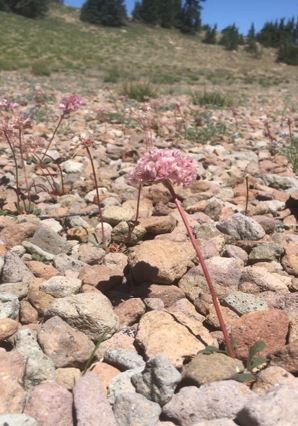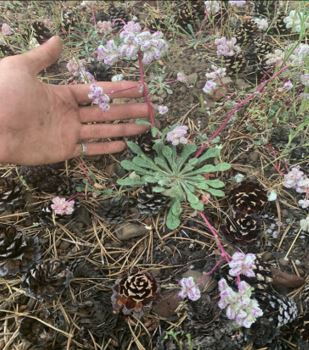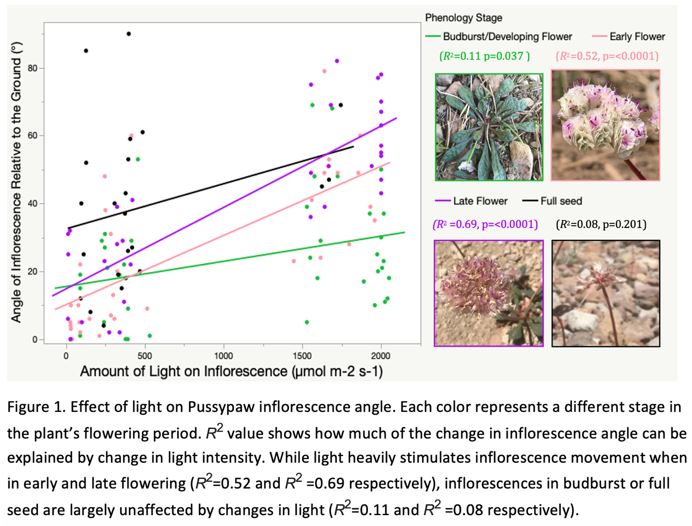The ground is sandy and rocky, exposed to full sun for most of the day. Any water that does arrive quickly leaves the topsoil since the large sand particles make room for it to pass. And yet despite this harsh environment, elegant ballroom dresses balanced upon disproportionately small stems slowly swing with intention. In these patches of exposed sandy soil where few others grow, the friendly waves and bewitching gowns attract many a visitor.
These alluring inflorescences belong to the common montane plant, Pussypaws (Calyptridium monospermum). While in direct sunlight, Pussypaw flower heads are frequently observed to be conspicuously raised up into the sky. However, as night falls or the shade of a conifer provides cover, Pussypaws let their flowers droop down, often entirely resting on the ground! This type of floral movement is unique to this genus of plants. It appears that they may use this distinctive ability to foster a wider range of relationships in places that would otherwise be mostly uninhabitable to plants. Despite how quaint and evolutionarily uncommon this floral phenomenon is, neither the main stimulus for this action nor its effect on plant fitness have been previously researched.

What stimulates them to move?
The simplest answer here is that the ground is really hot! On average, Pussypaw flowers in direct sunlight are 36 °F hotter when touching the ground if prevented from rising up. Therefore Pussypaws must rely on one or more specific environmental triggers to prompt their floral movement. We tested which of three main environmental cues were most responsible for inflorescence movement: light, temperature, or time of day.

Surprisingly, Pussypaws’ responses to environmental stimuli are different during each stage of the plant’s life history (Figure 1)! While the plants were in the process of developing functional flowers, inflorescences couldn’t be bothered to move significantly by changes in light, temperature, or time. However, during full flower, a change in the amount of direct sunlight (and the consequent shift in temperature) was nearly directly responsible for triggering an inflorescence movement over the course of less than an hour. After flowering is over, the plants produce seeds contained within papery little capsules. In this stage, light and temperature slightly affected floral movement, but the plants generally kept their flowers as close to 90° straight up as possible.

Why do Pussypaws dance?
A possible adaptive benefit of raising inflorescences is for more effective pollination. To test this hypothesis, I altered the angles of Pussypaw inflorescences with metal stakes so that on a single plant, a third of the flowers were propped up, a third staked down, and the last third left unaltered. I then recorded how many of each kind of insect landed on each of the three differently angled inflorescences. In the end, there was no strong difference between insect visitor rates to each of the three treatment groups, however a larger sample size is needed for more clear results.
Adaptions for effective pollination prove vital for Pussypaws since they attract a wide variety of visitors including native California bees, ants, bee-mimicking hoverflies, beetles, butterflies, and parasitoid wasps. I collected and pinned nine different species of these pussypaw visitors as part of a voucher specimen collection that (human) visitors can see at the Norris Center.
What can we learn?
We found evidence that floral movement provides three main benefits. Firstly, lowering flowers down during cooler temperatures is a great way to conserve water by avoiding desiccating wind. The California montane habitat is very dry in summer and a common plant strategy to cope with these conditions is to be compact and low to the ground. Low-lying flowers are great for water conservation, but not for pollination or seed dispersal. Fortunately, Pussypaws can raise their flowers in response to higher light levels! Not only does this allow them to show off their floral displays to pollinators, but also enhances their faintly sweet smell which is more volatile at higher temperatures. While in full flowering stage, light levels heavily influence Pussypaw inflorescence movement, which aligns with pollinator tendency to be most active in sunny weather.
Finally, perhaps the most interesting adaptive value we found evidence for is something we weren’t particularly looking for: enhanced seed dispersal. Remember from above how Pussypaws keep their flowers as high as possible when they are finished flowering and in full seed? Pussypaws disperse their seeds in the wind, which can happen most effectively when their lightweight dry seed capsules are high up above the ground. Consequently, ambient light levels have only minimal effect on inflorescence movement when the plants are in this stage.
Overall, Pussypaws teach that toughness and resilience amidst harsh conditions goes hand in hand with sensitive beauty and knowledge of when we are most able to give.
Acknowledgments
I’d like to thank the Norris Center for funding this project and encouraging artistic collaboration in science. This project wouldn’t have been possible without my two collaborators and advisors, Dr Tim Miller and Dr Jarmila Pittermann, whose joyful passion was just as important as their scientific input. I’d also like to thank Sagehen Reserve and their amazing on-site caretakers, including Dan Sayler and Ash Zemenick. All field work was done on unceded Washoe land.
